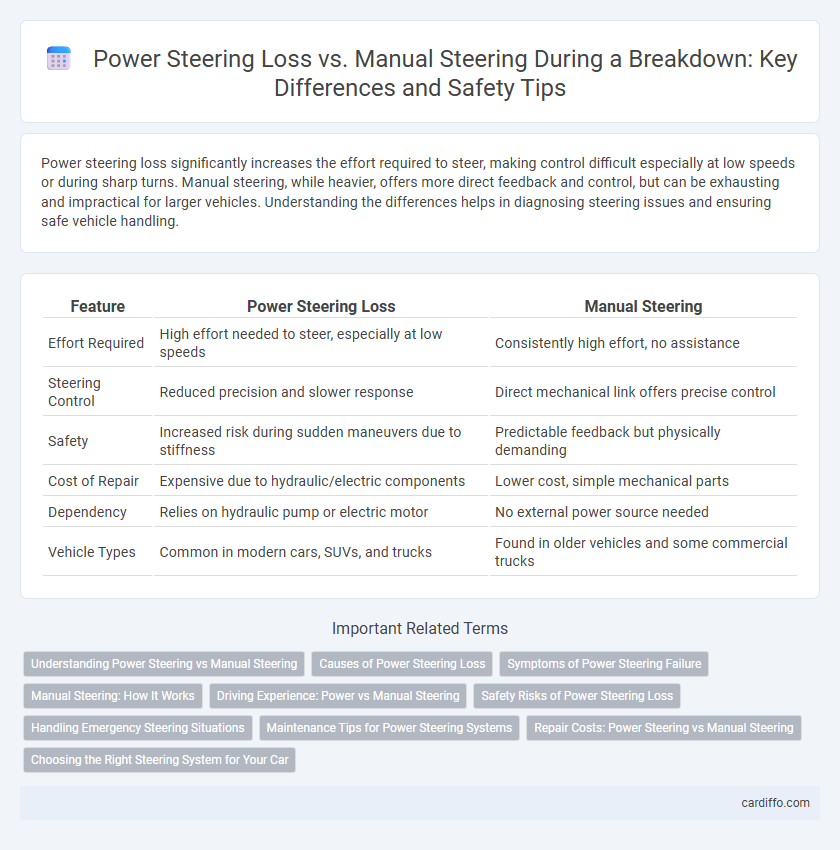Power steering loss significantly increases the effort required to steer, making control difficult especially at low speeds or during sharp turns. Manual steering, while heavier, offers more direct feedback and control, but can be exhausting and impractical for larger vehicles. Understanding the differences helps in diagnosing steering issues and ensuring safe vehicle handling.
Table of Comparison
| Feature | Power Steering Loss | Manual Steering |
|---|---|---|
| Effort Required | High effort needed to steer, especially at low speeds | Consistently high effort, no assistance |
| Steering Control | Reduced precision and slower response | Direct mechanical link offers precise control |
| Safety | Increased risk during sudden maneuvers due to stiffness | Predictable feedback but physically demanding |
| Cost of Repair | Expensive due to hydraulic/electric components | Lower cost, simple mechanical parts |
| Dependency | Relies on hydraulic pump or electric motor | No external power source needed |
| Vehicle Types | Common in modern cars, SUVs, and trucks | Found in older vehicles and some commercial trucks |
Understanding Power Steering vs Manual Steering
Power steering systems use hydraulic or electric assistance to reduce the effort required to turn the steering wheel, providing easier maneuverability and enhanced control compared to manual steering. In contrast, manual steering relies solely on driver strength to operate, offering more direct road feedback but demanding greater physical effort, especially at low speeds or during parking. Understanding these differences is essential for diagnosing breakdowns, as power steering failures often result in increased steering effort and can indicate issues like pump failure, fluid leaks, or electrical faults.
Causes of Power Steering Loss
Power steering loss commonly results from hydraulic fluid leaks, worn-out pump belts, or failure of the power steering pump, causing increased effort required to steer compared to manual steering systems. Air trapped in the power steering fluid or damaged steering rack seals can also reduce steering assist, leading to sudden stiffness in the steering wheel. Unlike manual steering's consistent mechanical link, power steering systems depend on hydraulic or electric components vulnerable to fluid contamination and pressure loss.
Symptoms of Power Steering Failure
Power steering failure typically manifests through symptoms such as increased steering effort, unusual whining or groaning noises when turning the wheel, and a stiff or unresponsive steering feel. Unlike manual steering, which requires consistent physical force but offers predictable feedback, a loss of power steering can cause sudden difficulty maneuvering, especially at low speeds. Early detection of fluid leaks, steering fluid contamination, or unusual vibrations can prevent complete power steering breakdowns.
Manual Steering: How It Works
Manual steering operates through a direct mechanical connection between the steering wheel and the wheels, typically via a steering column and rack-and-pinion or recirculating ball mechanism. This system relies solely on driver input without hydraulic or electric assistance, requiring more physical effort, especially at low speeds or when stationary. Unlike power steering, manual steering provides consistent feedback and control but demands greater strength for maneuvering.
Driving Experience: Power vs Manual Steering
Power steering offers effortless maneuverability, reducing driver fatigue during low-speed turns and parking, enhancing overall driving comfort. Manual steering provides a more direct and tactile connection to the road, preferred by enthusiasts for precise feedback and control. Loss of power steering significantly increases steering effort, compromising vehicle handling and safety in critical driving situations.
Safety Risks of Power Steering Loss
Loss of power steering significantly increases the risk of accidents due to the sudden increase in steering effort required to control the vehicle, especially at low speeds or during emergency maneuvers. Unlike manual steering, where the driver maintains consistent control force, power steering failure can lead to delayed reaction times and compromised vehicle stability. Safety risks escalate as drivers may struggle with precise steering input, increasing the likelihood of collisions and loss of vehicle control.
Handling Emergency Steering Situations
Power steering loss significantly impacts emergency handling by increasing the physical effort required to steer, making precise maneuvers difficult during critical moments. Manual steering systems, while requiring greater input under all conditions, offer predictable resistance that some drivers may find easier to control in emergency situations. Vehicles equipped with power steering rely on hydraulic or electric assistance that, when lost, can lead to slower steering response times and reduced vehicle control at high speeds.
Maintenance Tips for Power Steering Systems
Power steering systems require regular maintenance to prevent breakdowns, including checking and topping off power steering fluid, inspecting hoses for leaks or damage, and ensuring the power steering pump operates correctly. Unlike manual steering, power steering components are more complex and demand timely fluid changes and belt inspections to avoid costly repairs. Proper maintenance extends the life of the system, improves steering response, and prevents sudden loss of power assistance.
Repair Costs: Power Steering vs Manual Steering
Repair costs for power steering systems are generally higher than manual steering due to the complexity of components like hydraulic pumps, reservoirs, and electronic sensors. Manual steering repairs often involve simpler mechanical parts, resulting in lower labor and replacement expenses. Power steering issues may require specialized diagnostic equipment and fluid replacements, driving up overall maintenance costs compared to manual steering systems.
Choosing the Right Steering System for Your Car
Power steering offers ease of maneuverability, especially at low speeds, reducing driver fatigue and enhancing control in tight spots, while manual steering provides a more direct road feel and reliability with fewer mechanical components to fail. When choosing the right steering system for your car, consider factors such as driving conditions, vehicle size, and maintenance preferences, as power steering systems can suffer from fluid leaks and pump failures leading to potential breakdowns. Manual steering systems, though requiring more effort, typically have simpler mechanisms that reduce the risk of sudden power loss and costly repairs.
Power steering loss vs manual steering Infographic

 cardiffo.com
cardiffo.com